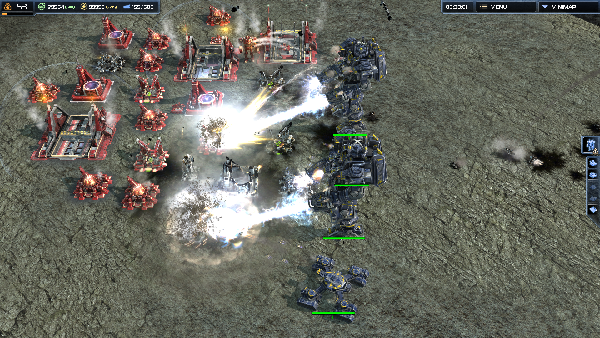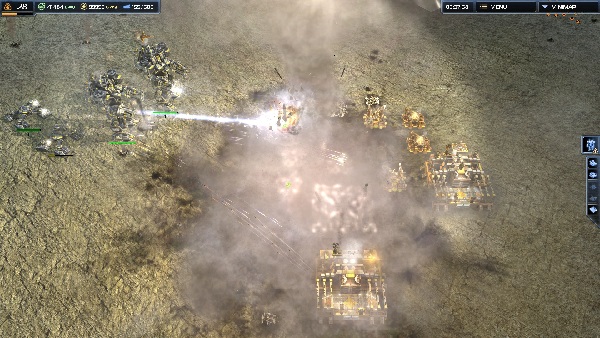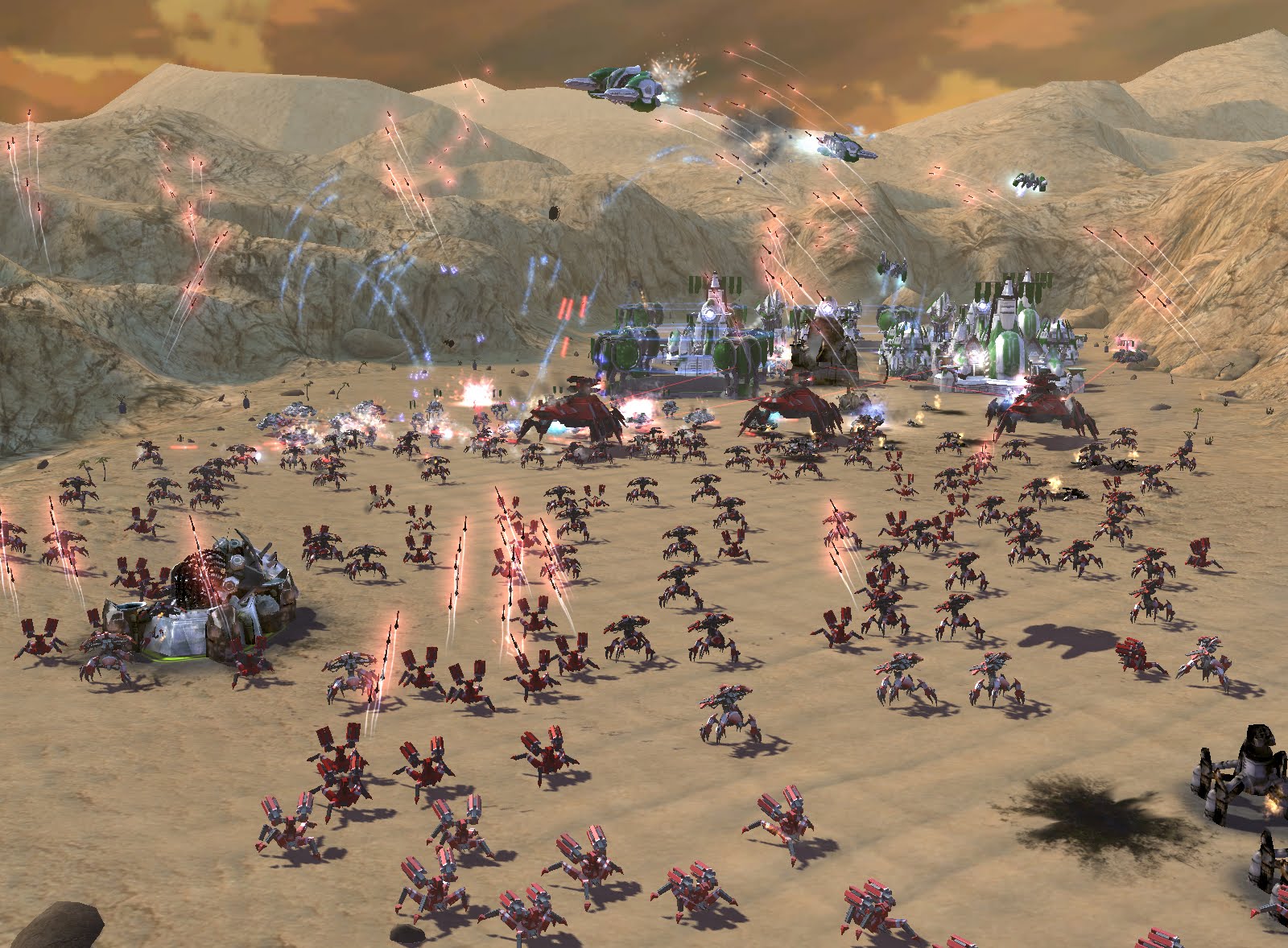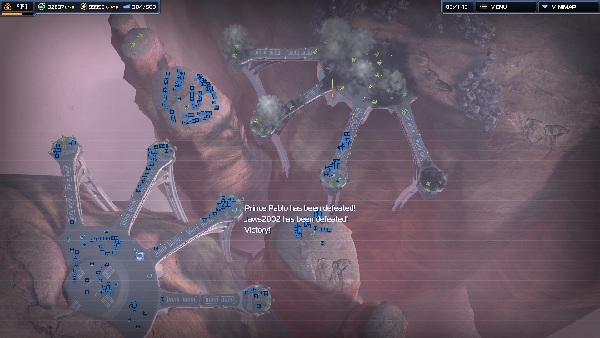Search
[{{{type}}}] {{{reason}}}
{{/data.error.root_cause}}{{{_source.title}}} {{#_source.showPrice}} {{{_source.displayPrice}}} {{/_source.showPrice}}
{{#_source.showLink}} {{/_source.showLink}} {{#_source.showDate}}{{{_source.displayDate}}}
{{/_source.showDate}}{{{_source.description}}}
{{#_source.additionalInfo}}{{#_source.additionalFields}} {{#title}} {{{label}}}: {{{title}}} {{/title}} {{/_source.additionalFields}}
{{/_source.additionalInfo}}Supreme Commander 2

Supreme Commander 2
Developed By: Gas Powered Games
Published By: Square Enix Ltd.
Released: March 2, 2010
ESRB Rating: E10+ for Everyone 10 and older: Fantasy Violence
Available On: PC, Xbox 360 Genre: Real Time Strategy
Number Of Players: 1 offline, up to 8 online multiplayer
Price: $9.99 US, Amazon
The Seraphim have fallen and the United Earth Federation (UEF), Cybran Nation and Aeon Illuminate have formed the Colonial Defense Coalition (CDC). These 25 years of peace are very different from the so-called Infinite War of the original Supreme Commander game. It is not destined to last; however, as the recently elected CDC president is assassinated. The finger pointing begins anew, and the factions return to war.
This lays down the foundation for the beginning of the three campaigns in Supreme Commander 2. These campaigns are not independent of one another, but actually require you to go through them in a specific order. This order begins with the UEF campaign, followed by the Illuminate, and finishing with Cybran’s campaign. Each campaign contains six missions, with the first couple helping the player understand the different units, structures, and technologies unique to each faction. All three storylines are tied together through the main characters, who were actually all friends back in academy.
The UEF is a standard human faction; they rely predominantly on tanks, artillery, and conventional weaponry to dominate their enemies. They are balanced in all areas, and do not have any one superior unit. The UEF’s main bonus is to their armor, and the ability to combine light and heavy artillery to dominate the map from almost any location. The UEF are a very balanced force that is able to compete at all stages of the game.

Strong Points: Interesting campaigns; Much smaller learning curve than its predecessor
Weak Points: Multiplayer is almost nonexistent; Very short campaigns
Moral Warnings: Violence
The Cybran Nation rely on fast moving units that have a high damage output. This benefit is countered by their units being the least armored of all three factions. The Cybran are combined human and AI. Originally serving the UEF, the Cybran Nation was formed when they demanded independence. They lack longer term benefits though, and as such are best suited for quick attacks on the other factions.
Finally, the Illuminate base their technology off of the main enemy from the first game, the Seraphim. The Illuminate are unique in that they lack any naval units. Instead, most of their land units are able to hover over the water. This is a disadvantage when facing actual naval ships, but allows for tactics unavailable with any other faction. The Illuminate is also the only faction to lack artillery, but do still benefit from tactical missile launchers that fill the role of the UEF’s light artillery. The Illuminate benefit from teleportation and extremely effective specialized experimental units.
The campaign is a good way to learn how to use each faction’s different tactics, while also containing a decent storyline along the way. While there are only the 18 missions in the campaign, they do still seem to take a while to complete. Most missions run on average about 45 minutes to an hour apiece, that results in a total completion time of about 13 and a half to 18 hours.

Higher is better
(10/10 is perfect)
Game Score - 79%
Gameplay - 15/20
Graphics - 7/10
Sound - 7/10
Stability - 4/5
Controls - 5/5
Morality Score - 94%
Violence - 8/10
Language - 10/10
Sexual Content -10/10
Occult/Supernatural - 9/10
Cultural/Moral/Ethical - --/10
For anyone unfamiliar with the Supreme Commander series, it is important to note a specific unit, the Armored Control Unit or ACU. This unit functions as a regular engineer unit, but not only does it build faster, it also functions as your commander in each game. All ACU’s are combat ready and can be upgraded further for combat, and depending on your faction have other abilities as well. The UEF ACU has the most weapon upgrades available and should win in any 1v1 commander fight when it is fully upgraded. The Cybran variant is exceptionally powerful against regular units, able to take on dozens of them at once. Finally, the Illuminate commander is the best commander for defense, as well as having the greatest resource generation upgrades of all three factions. It is also worth noting that when an ACU is destroyed it detonates a nuclear warhead that rivals the nuclear missiles launched from structures. This can be prevented with technology. At first, you might wonder why you would want to prevent this. After all, it is comforting to see all the enemy units perish after they killed your commander. However, try this when your commander is in the middle of your own base, and you will see the value in not setting off the nuclear explosion.
The controls are rather standard for a real time strategy game, but Supreme Commander 2 does contain one rather unique view that was carried over from the original. This strategic view allows you to zoom all the way out to see the entire map. Rather than simply giving you a great strategic view however, this screen still permits unit control as well as the use of structures like the nuclear launch facility. I frequently found myself using that screen to move units as well as keep apprised of the overall situation. There is still a minimap, but with the strategic view, there is really no need. An example of this view is below.
Supreme Commander 2 also contains a skirmish mode. This mode contains 26 different maps ranging from 1v1s to 4v4s. There are also some Free-for-all maps included as well, if you prefer that instead. It is worth noting that just because a map is designed for a 3v3 (like the one pictured above), enemies can be set to whatever team you desire, allowing for as many sides as there are players.

Graphically, Supreme Commander 2 looks satisfactory. The units, structures, explosions, and other effects are all rather impressive. That said, the main characters in the campaign look quite cartoonish and animated when compared with the rest of the game. The contrast between the two caused my experience to suffer. Other than that one exception, Supreme Commander 2 was pleasant to look at. It did seem to stutter once or twice on me, but that was with a very full map on my part while also zooming in and out across the map.
There are three resources to speak of in Supreme Commander 2. Mass and energy make a comeback from the original game, and research is added. Mass extractors must be placed over certain locations on the map, forcing conflict over these areas, while energy can be generated from structures in any location. Research points are also generated by structures that can be built at any location. Mass and energy are spent on units and structures, and research points unlock new technology for units, abilities, or other bonuses for whatever category you are researching.
I feel a review of this game would not be complete without addressing the primary difference from the original. In the first Supreme Commander, experimental units (think of hero type units) such as an aircraft carrier that can go underwater, or the much-loved Monkeylord spiderbot, could take an hour or more before you could have one built. These units could, with minimal support or in a pair, completely decimate your enemy. Long matches that culminated in these experimental units turning the tide were quite common for me in the first game. Supreme Commander 2 decided to do away with that concept in favor of a faster moving game. There are no longer tech levels for buildings, and experimental units can be built rather quickly into the game depending on how you apply your research points. Building these units quicker comes at a cost though: most can be destroyed with even a small to moderate sized army. That said, most of these units are still exceptional, and with proper support or in larger numbers are still quite deadly.
The multiplayer experience allows for only online play, meaning no LAN matches among friends. All of the previously mentioned maps for skirmish are available for multiplayer as well, but no new ones are available. There is a DLC expansion available that includes 14 more units as well as eight additional maps. Multiplayer is enjoyable, and can be played either with or against other players, and it is possible to add additional computer players to fight with as well. There are three modes: Assassination, Supremacy, and Infinite War. In Assassination, the goal is simply to kill the enemy ACUs. In Supremacy, you must destroy all enemy structures. Infinite War on the other hand is essentially a sandbox mode. No matter what you do, the match will continue until you end it.

When loading up multiplayer today (July 4th), I expected at least a half-dozen servers due to most people being off of work. I suppose that may have been optimistic, but when I logged in and checked for available games I saw only two servers. After about a minute, there was only one left. I expanded the search to include all regions and was still only presented with the one server. It is worth noting that I do not have the Infinite War expansion, and it may be possible that games with that expansion don’t show up in the vanilla game. It is also worth pointing out that the multiplayer screen showed over 1000 players logged in, so the multiplayer experience cannot be completely ruled out.
As far as moral issues go, violence is present in Supreme Commander 2, but very little other objectionable content was included. All three commanders in the campaigns do end up either defying superiors or engaging in illegal activities, but all do so in order to preserve lives and to try to restore peace in the end. Violence is confined to the destruction of robotic units or vehicles.
The story in the campaign was good, despite the character animations. The graphics for the units are great. The game speed has increased from the first game, which makes for a smaller learning curve. Additionally, there are no major moral issues present in the game. Overall, I enjoyed Supreme Commander 2 and I think it is worth its current price of $7.15 on Amazon.








